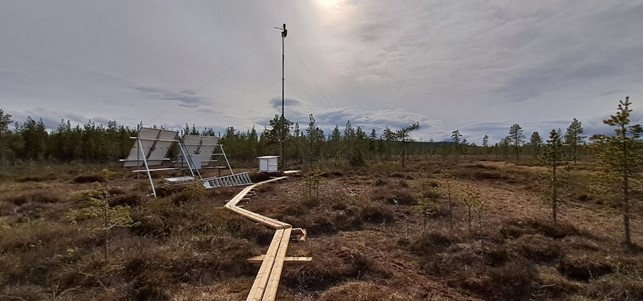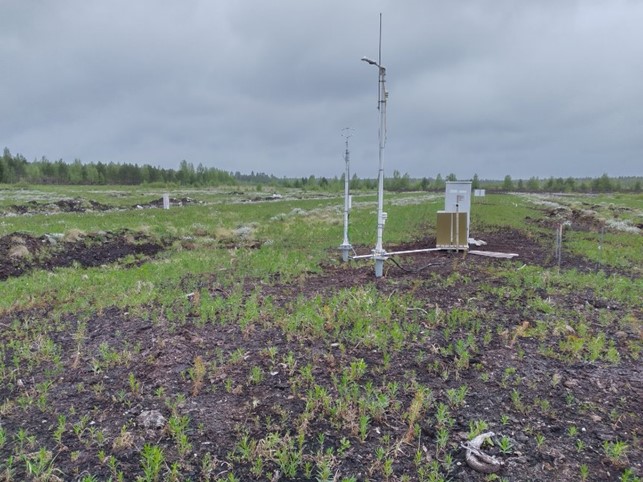The climate impacts of peatland land use
The Finnish Meteorological Institute is involved in several research projects studying the carbon cycle and greenhouse gas balances in differently managed peatlands. These include forest-drained peatlands and various forestry practices, peat fields, and restored forest-drained peatlands.
Research related to peatlands is conducted at the Finnish Meteorological Institute within the Carbon Cycle and Greenhouse Gases Research Groups. Additionally, numerous collaborators from both Finland and abroad are involved in various projects.
Ongoing research projects:
TURNEE – Forests on peatlands – solutions for reducing emissions and increasing of carbon sinks (2021–2024)
This project utilizes new measurements and modelling to study how much greenhouse gas emissions from the land use sector can be reduced by influencing the management and location of forests growing on peatlands. Restoration of forestry-drained peatlands and afforesting decommissioned peat extraction areas are studied. The focus is not only on the climate impacts of land use but also the effects on water systems and biodiversity.
LIFE Peat Carbon – Peatland restoration for greenhouse gas emission reduction and carbon sequestration in the Baltic Sea region (2022–2027)
The aim of the project is to implement climate change mitigation measures in peatlands, as well as to adapt and demonstrate innovative tools and applicable methods for greenhouse gas monitoring.
Horizon ALFAwetlands – Wetland restoration for the future (2022–2026)
The project improves the geospatial knowledge base of wetlands and evaluates the pathways of wetland restoration incorporating a co-creation process. The goal is also to provide information and indicators for sustainability to maximise the benefits related to climate, biodiversity, and the whole ecosystem.
Horizon WET HORIZONS – upgrading knowledge and solutions to fast-track wetland restoration across Europe (2022–2026)
The project aims to enhance wetland restoration using a holistic approach, with a specific focus on biodiversity. The project improves the current data available from pristine, drained, and rewetted peatlands, floodplains, and coastal wetlands, model the effects of typical restoration measures under variable conditions, and analyse the potential socioeconomic impacts. The final goal is to deliver guidelines and best management practices.
RESPEAT – Quantifying the potential of boreal peatland rewetting for climate change mitigation (2021–2025)
The project studies the impacts and climate-change-mitigation potential of rewetting peatlands. In the project, newly collected and existing data will be used to test and improve existing process-based models of carbon and greenhouse gas dynamics in peatlands. The project will provide a synthesis of the climate change mitigation potential of restoring Finnish and other northern peatlands.
EyeClima – Verifying emissions of climate forcers (2023–2026)
This research and innovation project aims to improve estimates of emissions and removals of the most important greenhouse gases as well as black carbon, to support European and international policy to reduce emissions.
JTF TUPSU (2024–2026)
The project will start during 2024.
Study sites:
Drained peatland forest, continuous cover forestry and clear-cut subsites. Ecosystem-scale flux measurements since 2010, another EC tower added 2016 at the clear-cut site.
Projects: TURNEE, ICOS, ALFAwetlands, WET HORIZONS
Partners: FMI, Luke, University of Helsinki / Forest science
Drained peatland forest, rewetting in 2024. Ecosystem-scale CO₂ and CH₄ flux measurements.
Projects: TURNEE, RESPEAT, ICOS, ALFAwetlands, WET HORIZONS
Partners: University of Helsinki / INAR & Forest science, FMI
Drained for forestry in 1960–1970, restoration in 2024 by cutting the trees and blocking the ditches. Ecosystem-scale CO₂ flux measurements in Matorovansuo.
Projects: LIFE PeatCarbon
Partners: FMI, Luke, University of Oulu

Matorovansuo (photo: Jack Chapman)
Nutrient-rich, spruce dominated, measurements since 2019–. Ecosystem-scale CO₂ flux measurements.
Projects: CANEMURE
Partners: Luke, FMI
Nutrient-poor peatland forest, rewetting in 2024. Ecosystem-scale CO₂ and CH₄ flux measurements.
Partners: FMI, University of Helsinki / Forest science
Naarasneva
Cutover peatland, peat production ceased in 2020, afforested in 2022. Ecosystem-scale CO₂ flux measurements since 2021–, N₂O since 2024–.
Projects: TURNEE, JTF TUPSU
Partners: University of Helsinki / INAR & Forest science, SeAMK, University of Oulu, FMI
Data from Naarasneva can be seen in TURNEE webpage (in Finnish)

Naarasneva (kuva: Kari Laasasenaho)
Miehonsuo
Cutover peatland which will be rewetted. Ecosystem-scale CO₂ and CH₄ flux measurements are planned to start in 2024.
Projects: JTF POP
Partners: University of Oulu, FMI, Syke, Luke
Why study peatlands?
Peatlands have evolved over thousands of years, with incomplete decomposition of plant remains due to high water levels. About half of peat consists of carbon, which plants have absorbed from the atmosphere as they grow. Therefore, peatlands are significant carbon stores both in Finland and globally. In oxygen-poor conditions in peatlands, methane is also produced, which ends up in the atmosphere. The long-term cooling effect of accumulated carbon outweighs the warming effect of methane in most cases. Natural peatlands thus have had and continue to have a cooling effect on the climate, but drainage and land use for agriculture and forestry release carbon stored in peat, warming the climate.
In Finland, over half of peatlands have been drained, mainly for forestry and agriculture. Drainage has improved conditions for tree growth and crop cultivation. Most of the drainage occurred in the 1960s to 1980s. As water levels drop, old peat starts to decompose. When the water level declines, peat comes into contact with oxygen, and microbial decomposition intensifies, releasing carbon dioxide into the atmosphere. The carbon dioxide released from drained peatlands is a significant greenhouse gas, causing climate warming. Recently, more and more peatlands are being restored by blocking drainage ditches and raising water levels back near the surface of the peat. Restoration aims to protect peatland ecosystems and prevent the release of old carbon into the atmosphere.
Why is the Finnish Meteorological Institute involved in peatland research?
The Finnish Meteorological Institute studies greenhouse gas concentrations in the atmosphere and the exchange of greenhouse gases between ecosystems and the atmosphere in various ecosystems. Peatlands are important in this regard because the land use of peatlands, including former peatlands used for cultivation and forestry, causes significant climate emissions.
News:
Researchers are investigating how the restoration of a peatland affects its greenhouse gases, vegetation, and hydrological conditions (Press release (originally in Finnish) | 6.3.2024)
LIFE Peat Carbon news on the project’s website.
ALFAwetlands blog on the project’s website.
WET HORIZONS news on the project’s website.
Past events:
European Peatlands Conference "Power to the Peatlands" | 19–21 September 2023
The European Peatland Conference "Power to the Peatlands", also called European Peatland Symposium took place in Antwerp, Belgium. Over 500 participants attended the conference. The different sessions and workshops of the event were focusing on scientific, political and management aspects of peatland restoration as well as conservation.
Greenhouse gas inventory seminar for experts at FMI, in Helsinki Finland | 6 September 2023
Researchers from the Finnish Meteorological Institute and Natural Resources Institute (LUKE) were brought together in a discussion with national greenhouse gas inventory makers from Statistics Finland and LUKE. Together they reviewed the methodology and implementation of the national inventory, and search for synergies and collaboration.
Field works in Finland | 23 May 2023
The summer monitoring season started in Pallas region in May, when the snow finally melted, and the first green shoots started to be visible on the mires. The area of the site was exceptionally wet this spring.
LIFE PeatCarbon project monitoring calibration meeting in Helsinki | 28–30 March 2023
The meeting brought together participants from Latvia, Germany, Denmark and Finland to discuss the peatland monitoring methodologies and their harmonization in Latvia and Finland. On the last day of the meeting the participants visited the Tervalamminsuo and Lettosuo site field measurement sites in Southwestern Finland, where some of the oldest and deepest peatlands in Finland occur.
Greenhouse gas measurements started in Finland | autumn 2022
The greenhouse gas (GHG) monitoring sites were established in the Finnish project sites Matorovansuo and Välisuo peatlands, located in Pallas, northern Finland. At first, boardwalks were established, and after that the GHG measurement points were marked and with water table monitoring wells and data loggers for recording soil temperature and moisture. The first measurements for the GHG flux monitoring were conducted in the same autumn.
LIFE PeatCarbon Kick-Off | 29–30 November 2022
Project’s kick-off meeting was organized at the University of Latvia in Riga, with 35 participants.
6.5.2024